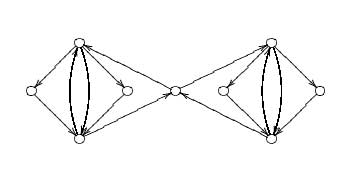The previous post can be found [here][1].
Pierre Gabriel invented a lot of new notation (see his book [Representations of finite dimensional algebras][2] for a rather extreme case) and is responsible for calling a directed graph a quiver. For example,
$\xymatrix{\vtx{} \ar@/^/[rr] & & \vtx{} \ar@(u,ur) \ar@(d,dr) \ar@/^/[ll]} $
is a quiver. Note than it is allowed to have multiple arrows between vertices, as well as loops in vertices. For us it will be important that a quiver $Q $ depicts how to compute in a certain non-commutative algebra : the path algebra $\mathbb{C} Q $. If the quiver has $k $ vertices and $l $ arrows (including loops) then the path algebra $\mathbb{C} Q $ is a subalgebra of the full $k \times k $ matrix-algebra over the free algebra in $l $ non-commuting variables
$\mathbb{C} Q \subset M_k(\mathbb{C} \langle x_1,\ldots,x_l \rangle) $
Under this map, a vertex $v_i $ is mapped to the basis $i $-th diagonal matrix-idempotent and an arrow
$\xymatrix{\vtx{v_i} \ar[rr]^{x_a} & & \vtx{v_j}} $
is mapped to the matrix having all its entries zero except the $(j,i) $-entry which is equal to $x_a $. That is, in our main example
$\xymatrix{\vtx{e} \ar@/^/[rr]^a & & \vtx{f} \ar@(u,ur)^x \ar@(d,dr)_y \ar@/^/[ll]^b} $
the corresponding path algebra is the subalgebra of $M_2(\mathbb{C} \langle a,b,x,y \rangle) $ generated by the matrices
$e \mapsto \begin{bmatrix} 1 & 0 \\ 0 & 0 \end{bmatrix} $ $ f \mapsto \begin{bmatrix} 0 & 0 \\ 0 & 1 \end{bmatrix} $
$a \mapsto \begin{bmatrix} 0 & 0 \\ a & 0 \end{bmatrix} $ $b \mapsto \begin{bmatrix} 0 & b \\ 0 & 0 \end{bmatrix} $
$x \mapsto \begin{bmatrix} 0 & 0 \\ 0 & x \end{bmatrix} $ $y \mapsto \begin{bmatrix} 0 & 0 \\ 0 & y \end{bmatrix} $
The name \’path algebra\’ comes from the fact that the subspace of $\mathbb{C} Q $ at the $(j,i) $-place is the vectorspace spanned by all paths in the quiver starting at vertex $v_i $ and ending in vertex $v_j $. For an easier and concrete example of a path algebra. consider the quiver
$\xymatrix{\vtx{e} \ar[rr]^a & & \vtx{f} \ar@(ur,dr)^x} $
and verify that in this case, the path algebra is just
$\mathbb{C} Q = \begin{bmatrix} \mathbb{C} & 0 \\ \mathbb{C}[x]a & \mathbb{C}[x] \end{bmatrix} $
Observe that we write and read paths in the quiver from right to left. The reason for this strange convention is that later we will be interested in left-modules rather than right-modules. Right-minder people can go for the more natural left to right convention for writing paths.
Why are path algebras of quivers of interest in non-commutative geometry? Well, to begin they are examples of _formally smooth algebras_ (some say _quasi-free algebras_, I just call them _qurves_). These algebras were introduced and studied by Joachim Cuntz and Daniel Quillen and they are precisely the algebras allowing a good theory of non-commutative differential forms.
So you should think of formally smooth algebras as being non-commutative manifolds and under this analogy path algebras of quivers correspond to _affine spaces_. That is, one expects path algebras of quivers to turn up in two instances : (1) given a non-commutative manifold (aka formally smooth algebra) it must be \’embedded\’ in some non-commutative affine space (aka path algebra of a quiver) and (2) given a non-commutative manifold, the \’tangent spaces\’ should be determined by path algebras of quivers.
The first fact is easy enough to prove, every affine $\mathbb{C} $-algebra is an epimorphic image of a free algebra in say $l $ generators, which is just the path algebra of the _bouquet quiver_ having $l $ loops
$\xymatrix{\vtx{} \ar@(dl,l)^{x_1} \ar@(l,ul)^{x_2} \ar@(ur,r)^{x_i} \ar@(r,dr)^{x_l}} $
The second statement requires more work. For a first attempt to clarify this you can consult my preprint [Qurves and quivers][3] but I\’ll come back to this in another post. For now, just take my word for it : if formally smooth algebras are the non-commutative analogon of manifolds then path algebras of quivers are the non-commutative version of affine spaces!
[1]: http://www.neverendingbooks.org/index.php?p=71
[2]: http://www.booxtra.de/verteiler.asp?site=artikel.asp&wea=1070000&sh=homehome&artikelnummer=000000689724
[3]: http://www.arxiv.org/abs/math.RA/0406618
